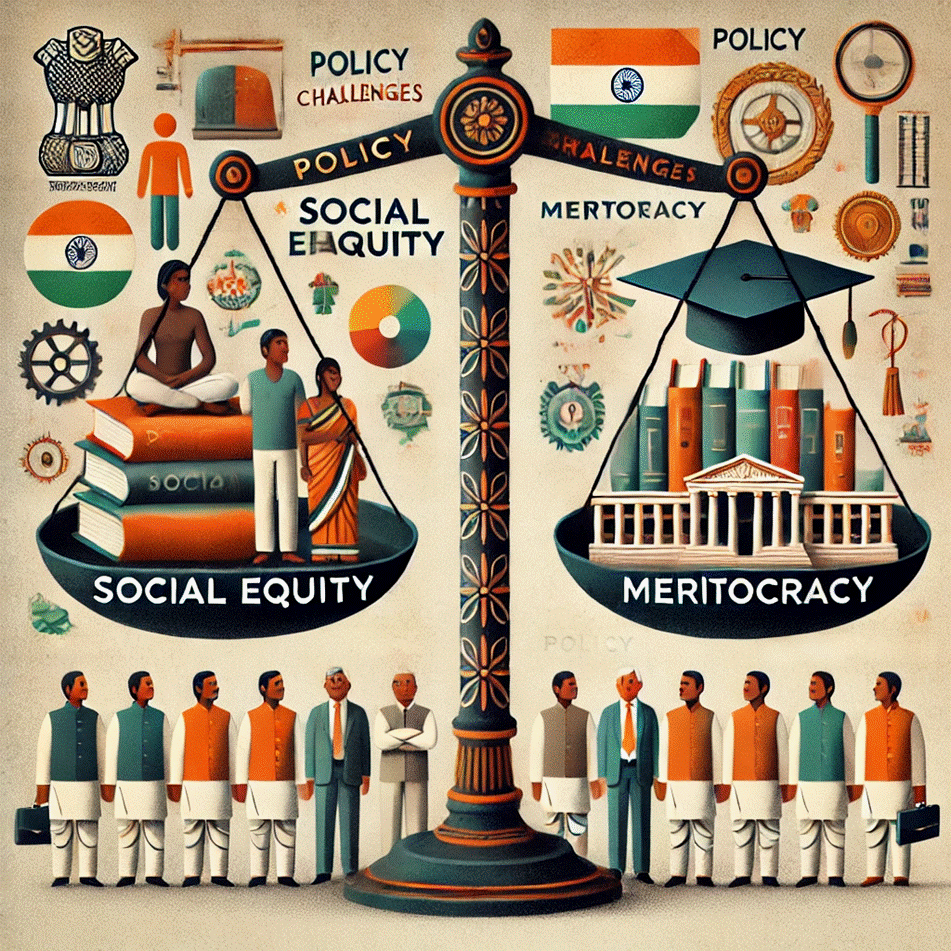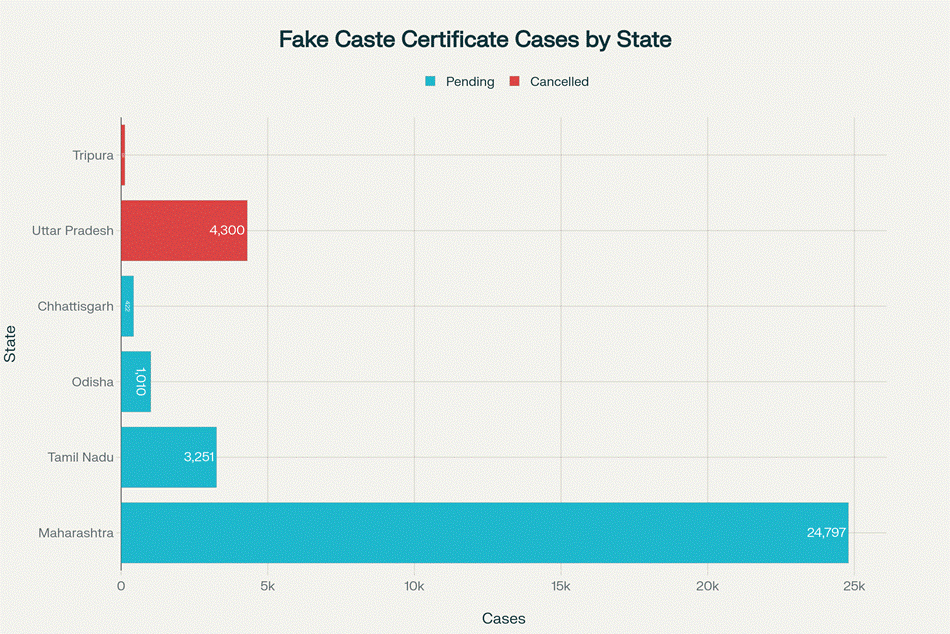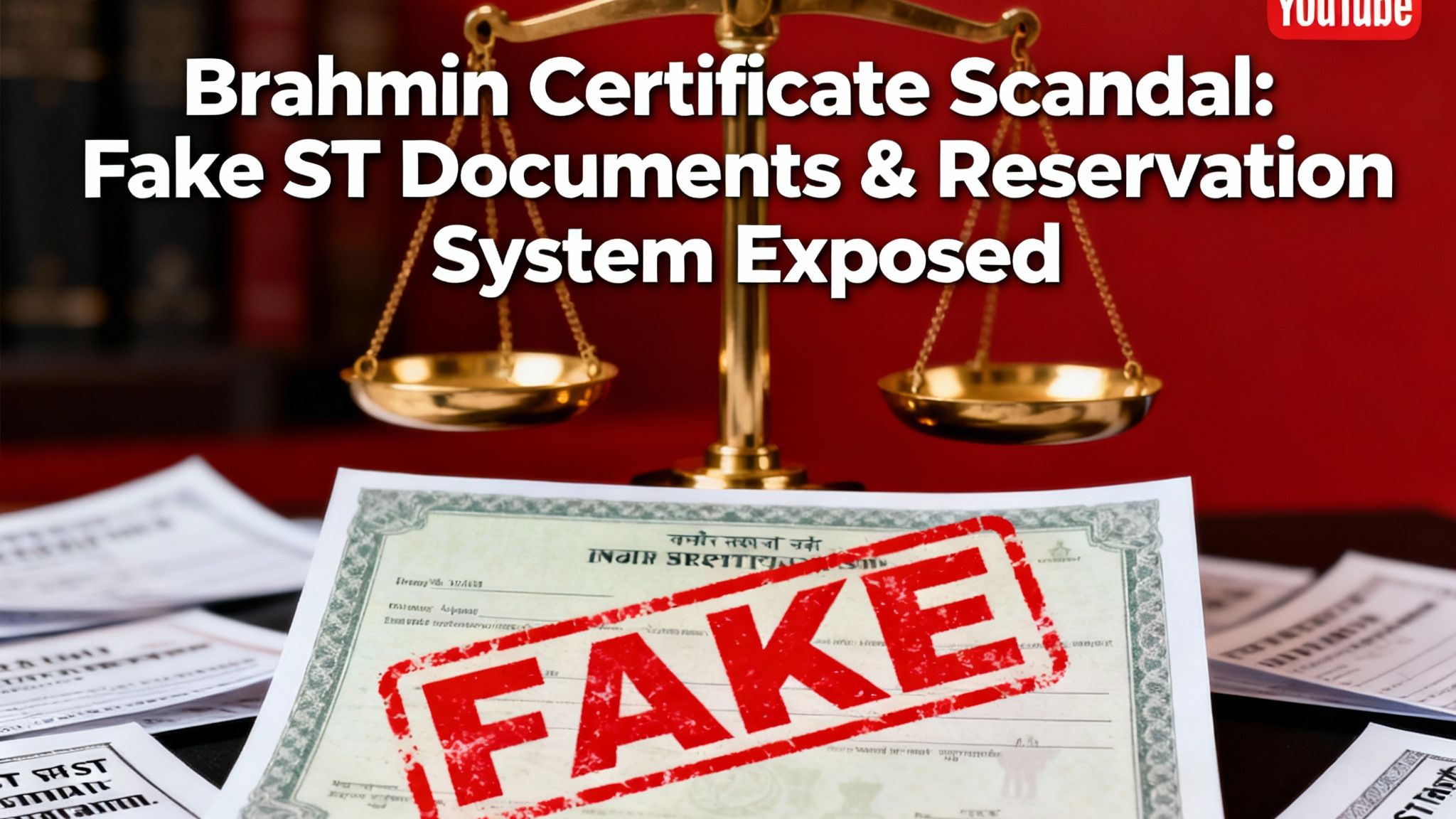The Brahmin Certificate Scandal: How Fake ST Documents Undermined India’s Reservation System
India’s reservation system stands at a critical juncture as investigations reveal systematic abuse that threatens the very foundation of social justice policies designed to uplift historically marginalized communities. The National Commission for Scheduled Tribes (NCST) investigation that exposed 4,341 individuals from upper-caste Brahmin communities allegedly securing government jobs using fraudulent Scheduled Tribe (ST) certificates in Uttar Pradesh represents one of the most significant challenges to the integrity of India’s affirmative action framework. This extensive fraud, primarily involving Brahmin Naik and Brahmin Ojha castes who obtained fake Gond tribe certificates, not only deprives genuine ST beneficiaries of their constitutional rights but also undermines decades of efforts to create an equitable society.[1][2]

Balancing social equity and meritocracy in India’s reservation system highlights policy challenges and the social debate.
Historical Context and Constitutional Framework of India’s Reservation System
India’s reservation system emerged from the recognition that centuries of caste-based discrimination had created deep structural inequalities that could not be addressed through equality provisions alone. The Constitution makers, led by Dr. B.R. Ambedkar, understood that “equality of opportunity” required more than formal equality—it demanded positive discrimination to level the playing field for historically oppressed communities. Articles 15(4) and 16(4) of the Constitution specifically empower the state to make provisions for the advancement of socially and educationally backward classes, including SCs and STs.[3][4][5]
The reservation framework allocates 15% of seats for Scheduled Castes, 7.5% for Scheduled Tribes, and 27% for Other Backward Classes, with an additional 10% reservation for Economically Weaker Sections introduced through the 103rd Constitutional Amendment in 2019. This system aims to ensure not just jobs but meaningful representation in decision-making processes, recognizing that public employment provides both livelihood and social status essential for community empowerment.[6][5][3]
The Supreme Court’s landmark judgment in Indra Sawhney v. Union of India (1992) established crucial principles including the 50% ceiling on reservations, the concept of creamy layer exclusion for OBCs, and the mandate that reservations must not compromise administrative efficiency. However, the effectiveness of these safeguards depends critically on the integrity of the certification process—precisely where the Uttar Pradesh scandal reveals systemic vulnerabilities.[4]
The NCST Investigation: Uncovering Systematic Fraud
The investigation that exposed the magnitude of certificate fraud in Uttar Pradesh began with a complaint from the Dalit Aadivasi Jeevan Jyoti Foundation, a Noida-based organization. This complaint alleged that individuals belonging to Brahmin Naik and Brahmin Ojha castes had obtained fake caste certificates claiming to belong to the Gond tribe and secured government jobs under the reserved category. The allegations were particularly concerning as they involved districts across eastern Uttar Pradesh, including Gorakhpur, Deoria, Maharajganj, Basti, Azamgarh, Mau, and Ballia.[1][7][2]

Tehsil map of Sonbhadra district in Uttar Pradesh showing administrative divisions and neighboring districts and states.
The NCST’s six-year investigation revealed the sophisticated nature of this fraud. The Commission deployed software verification techniques alongside traditional documentation review to identify discrepancies in certificate authenticity. The investigation methodology included demanding detailed reports from the state government regarding caste breakdowns in different districts, population data for genuine Gond tribals versus Brahmin Naik and Brahmin Ojha communities, and documentation of any complaints received about fake certificates.[1][7]
The scale of the problem became apparent when the investigation expanded beyond Uttar Pradesh. Maharashtra emerged as having the highest number of pending fake certificate cases with 24,797 complaints, while Tamil Nadu had 3,251 cases, and Odisha recorded 1,010 cases. In stark contrast to other states where cases remained pending, Uttar Pradesh had cancelled 4,300 certificates since 2012, though significantly, all these cancellations were subsequently challenged in high courts with stay orders issued.[2][1]

Scale of Fake Caste Certificate Cases Across Indian States
NCST Secretary Raghav Chandra highlighted a critical weakness in the enforcement mechanism: “They cancel the caste certificates but no FIR is filed to press criminal charges. This is another reason the person continues in the system till the court takes a final view on the matter”. This procedural gap allowed fraudulent beneficiaries to continue in their positions for years while legal proceedings remained pending.[1][2]
Geographic Concentration and the Kol Tribe Identity Crisis
The investigation revealed specific geographic patterns in the fraud, with districts like Sonbhadra, Chandauli, and Mirzapur emerging as hotspots. These districts, located in southeastern Uttar Pradesh, have significant tribal populations and complex administrative histories that created opportunities for identity fraud.[8][9][10]

Map of Sonbhadra district in Uttar Pradesh showing key towns, roads, and neighboring districts and states relevant to the reservation policy misuse investigation.
A particularly concerning aspect involves the misuse of the Kol tribe identity, which highlights the complexity of India’s federal approach to tribal recognition. The Kol tribe presents a unique case study in how administrative inconsistencies can be exploited for fraudulent purposes. While Kols are recognized as Scheduled Tribes in Madhya Pradesh, they hold only Scheduled Caste status in Uttar Pradesh. This differential recognition created opportunities for individuals to claim tribal status inappropriately.[10]
The Kol community, tracing their lineage to the legendary Shabari of the Ramayana, primarily inhabits districts including Chitrakoot, Sonbhadra, Mirzapur, and Chandauli in Uttar Pradesh, as well as areas in Madhya Pradesh. Despite their legitimate tribal heritage and demand for ST status in Uttar Pradesh, the community’s complex administrative classification has been exploited by fraudulent claimants. The irony is stark: while genuine Kol community members struggle for recognition of their tribal status in UP, others have falsely appropriated tribal identities to gain reserved category benefits.[10]
Research shows that Sonbhadra district has emerged as particularly vulnerable to such fraud due to its history of land disputes, displacement from development projects, and the marginalization of genuine tribal communities. The district’s tribal population faces ongoing challenges from land grabbing by powerful interests, making the additional burden of identity fraud particularly devastating for legitimate beneficiaries.[8]
Impact on Genuine Beneficiaries: A Constitutional Crisis
The human cost of certificate fraud extends far beyond statistical anomalies—it represents a fundamental violation of constitutional promises made to India’s most vulnerable communities. When fraudulent claimants occupy seats reserved for SCs and STs, they directly deprive genuine candidates of opportunities in education, employment, and social mobility that the Constitution specifically guarantees.[11][12]
The Supreme Court has recognized this deprivation as particularly egregious. In recent judgments, the Court emphasized that using fake caste certificates for employment or education results in loss of both degree and job, regardless of the duration of service. Justice emphasized: “Even if a person has been in job for 20 years on the basis of a fake caste (document), he will lose the job and also get punished”.[12]
The impact becomes more severe when considering the limited scale of opportunities. With only 7.5% of all government positions reserved for STs and 15% for SCs, each fraudulent appointment has a magnified effect on genuine candidates. In central government organizations alone, 1,832 appointments were allegedly secured through fake caste certificates, with 276 resulting in suspension or removal, while 521 cases remained entangled in litigation.[3][12]
The psychological and social impact on genuine tribal communities cannot be quantified. Tribal communities that have faced centuries of marginalization and exclusion see their constitutional rights being appropriated by the very social groups that historically oppressed them. This creates a profound sense of injustice that undermines confidence in democratic institutions and the rule of law.
Educational institutions face similar challenges. When fraudulent claimants secure admission to professional courses or higher educational institutions using fake certificates, they occupy seats that should have gone to genuine SC/ST students. This perpetuates educational inequality and denies marginalized communities access to the professional qualifications necessary for social mobility.
Legal and Administrative Response Framework
The legal framework for addressing caste certificate fraud has evolved through landmark Supreme Court judgments, particularly Kumari Madhuri Patil vs Additional Commissioner Tribal Development (1994). This case established mandatory verification procedures that remain binding on all authorities issuing caste certificates. The Court held that any admission or employment wrongly obtained through false social status certificates automatically deprives genuine SC/ST candidates of their constitutional rights.[13][14]
The Madhuri Patil judgment established a comprehensive verification framework requiring:
- Constitution of a three-member committee including an Additional Joint Secretary, Director of Social Welfare, and an officer with intimate knowledge of certificate verification[14]
- Creation of vigilance cells with Senior Deputy Superintendent of Police oversight and Police Inspectors for investigation[14]
- Physical verification by visiting the candidate’s place of residence or origin[14]
- Bipartite hearings with show-cause notices if certificates are found doubtful[14]
Despite these clear guidelines, enforcement remains problematic across states. The Supreme Court noted in subsequent judgments that states fail to follow proper procedures, often not filing FIRs against fraudulent claimants, and high courts frequently issue stay orders that allow fraudulent beneficiaries to continue in service during prolonged legal proceedings.[1][2]
Recent administrative responses show mixed results. The Department of Personnel and Training (DoPT) has issued clear instructions for removing candidates found with forged certificates. However, implementation varies significantly across states and organizations. Parliamentary committees have called for online verification systems and digital certificate issuance to improve transparency and reduce manipulation.[15][16]
The legal consequences for fraud are severe but inconsistently applied. Criminal charges under Indian Penal Code sections including 420 (cheating), 464, 465, 468 (forgery) can result in imprisonment up to five years with substantial fines. In one notable case, Delhi courts sentenced a man to five years rigorous imprisonment and Rs 75,000 fine for using fake ST certificates to secure two government jobs.[17]
Technological Solutions and Digital Verification Initiatives
Recognition of the scale and persistence of certificate fraud has prompted innovative technological responses across several states. Maharashtra has emerged as a pioneer in implementing blockchain technology for caste certificate validation. The system, launched in Etapalli sub-division of Gadchiroli district, issues certificates with QR codes anchored on Polygon blockchain, enabling instant verification and preventing forgery.[18][19]

Official and digital verification of caste certificates to prevent fraud using advanced technology like biometrics and blockchain.
The blockchain implementation addresses several critical vulnerabilities in traditional paper-based systems:
- Immutable record-keeping that prevents post-issuance tampering
- Real-time verification capabilities for recruiting agencies
- Cryptographic security that makes forgery technically infeasible
- Transparent audit trails for accountability [18][19]
West Bengal has initiated discussions on Application Programming Interface (API) integration with the School Service Commission to enable single-click verification of caste certificates. This system aims to eliminate manual verification processes that are time-consuming and prone to human error. [20]
Haryana has developed comprehensive digital verification protocols requiring communication with state authorities within one week of an employee joining government service. The system mandates that state authorities verify and report certificate authenticity within one month of receiving verification requests. [16]
The technological solutions show promising results in pilot implementations. In Maharashtra’s blockchain pilot, 65,000 caste certificates were processed through the system within two months, with significant reductions in fraudulent applications. However, nationwide implementation faces challenges including digital infrastructure limitations, resistance from vested interests, and the need for coordinating across multiple state governments.[19][18]
Systemic Vulnerabilities and Reform Imperatives
The Uttar Pradesh scandal reveals fundamental weaknesses in India’s federal approach to caste certificate administration. Unlike centralized systems for Aadhaar or PAN cards, caste certificate issuance remains a state subject with significant variations in procedures, verification mechanisms, and enforcement standards.[1][21]
Key systemic vulnerabilities include:
Inconsistent Documentation Standards: Different states accept varying forms of proof for caste claims, creating opportunities for forum shopping and document manipulation. Some states empower all gazetted officers to issue certificates, while others maintain more restricted authorization.[21]
Inadequate Cross-Verification Mechanisms: The absence of real-time databases allowing authorities to check if individuals hold multiple certificates from different states facilitates fraud. The Hathras incident, where 814 birth certificates were issued from a single village ID across multiple states, demonstrates how localized fraud can have national implications.[22][23]
Judicial Bottlenecks: High courts frequently issue stay orders when certificates are cancelled, allowing fraudulent beneficiaries to continue in positions for years while cases remain pending. The Supreme Court has criticized this practice but enforcement remains inconsistent.[2][1]
Political Economy Factors: Reservation has become deeply embedded in electoral politics, with various groups demanding inclusion and politicians reluctant to take strong action against fraud that might alienate vote banks. This political dimension complicates administrative reforms.[24]
Limited Prosecution: States rarely file FIRs against fraudulent claimants, focusing instead on administrative cancellation of certificates. Without criminal consequences, the deterrent effect remains minimal.[1][2]
Broader Implications for Social Justice and Democratic Governance
The certificate fraud scandal raises fundamental questions about the sustainability and credibility of India’s reservation system. When affirmative action policies designed to promote social justice become vehicles for perpetuating privilege, they risk losing public legitimacy and support.[24]
The scandal particularly challenges the assumption that social identities are fixed and easily verifiable. In India’s complex caste hierarchy, individuals and communities may have multiple identities across different regions and historical periods. While this complexity should not excuse fraud, it suggests the need for more nuanced approaches to identity verification that account for historical migrations, inter-marriage, and social mobility.[10]
The timing of these revelations is particularly significant as India approaches the 75-year milestone of its reservation policies. The Supreme Court has recently indicated that Parliament and executive must consider whether current beneficiaries who have achieved economic advancement should continue receiving reservation benefits. The Court emphasized that “75 years of benefits” may be sufficient for some communities, and the creamy layer principle should apply more rigorously.[25]
This judicial intervention reflects growing concerns that reservation benefits are increasingly captured by the relatively privileged members of scheduled communities rather than reaching the most disadvantaged. When combined with outright fraud by non-beneficiary communities, the cumulative effect threatens to make reservation a mechanism for elite circulation rather than genuine social transformation.[25]
International comparison provides additional perspective. Affirmative action programs in other democracies, including the United States and South Africa, have faced similar challenges regarding beneficiary authenticity and elite capture. However, India’s system faces unique complexities due to the constitutional permanence of reservations, the federal structure requiring coordination across states, and the intersection with electoral politics.[24]
Recommendations for Systemic Reform
Addressing the crisis revealed by the Uttar Pradesh scandal requires comprehensive reforms across multiple dimensions:
Immediate Administrative Measures:
Mandatory Digital Verification: All states should implement blockchain-based or API-integrated systems for certificate issuance and verification within 24 months. The Maharashtra model should be scaled nationally with central government coordination.[18][19][15]
Real-Time Database Integration: Creation of a national database linking all caste certificates issued across states, enabling cross-verification and preventing multiple certificates. This system should integrate with recruitment portals for automatic verification.[15]
Streamlined Verification Timelines: State authorities must complete certificate verification within 30 days of request, with automatic approval if no response is received. This prevents indefinite delays that currently plague the system.[16]
Enhanced Criminal Enforcement: States must mandatorily file FIRs against fraudulent claimants and issue detailed investigation reports within 90 days. Special fast-track courts should handle certificate fraud cases.[1][2]
Structural Reforms:
Constitutional Amendment for Uniform Standards: A constitutional amendment establishing uniform procedures and standards for caste certificate issuance across all states would address current inconsistencies and forum shopping opportunities.[21]
Periodic Review Mechanism: Implementation of mandatory 10-year reviews of reservation policies with data-driven assessment of beneficiary patterns and fraud detection. This would identify communities that have achieved sufficient advancement and those requiring continued support.[26]
Creamy Layer Extension: Application of income and social advancement criteria to SC/ST categories, similar to OBC creamy layer exclusion. The Supreme Court has indicated this reform is overdue and necessary for targeting benefits to the most disadvantaged.[25]
Technology and Governance Measures:
Artificial Intelligence Integration: AI-powered systems should analyze patterns in certificate applications to flag suspicious cases for enhanced verification. Machine learning algorithms can identify anomalies in documentation and application patterns.[18]
Biometric Integration: Linking all certificates to Aadhaar with biometric verification ensures individual accountability and prevents impersonation. This creates an immutable link between identity and benefits.[27]
Third-Party Audit Systems: Independent auditing organizations should randomly verify certificates and investigate complaints through anonymous reporting mechanisms. This provides external oversight of state verification processes.[15]
Community Empowerment and Awareness:
Genuine Beneficiary Education: Comprehensive awareness campaigns should inform SC/ST communities about their rights, application procedures, and complaint mechanisms. Many genuine beneficiaries lack awareness of available opportunities.[10]
Civil Society Engagement: Partnerships with tribal rights organizations and Dalit groups can strengthen monitoring and advocacy for enforcement. The Dalit Aadivasi Jeevan Jyoti Foundation’s complaint that triggered the NCST investigation demonstrates the importance of civil society oversight.[7][1]
Community Verification Processes: Local community leaders and traditional institutions should be involved in initial verification processes, providing cultural knowledge and social accountability.[14]
Conclusion: Restoring Faith in Constitutional Promises
The revelation of systematic fraud in caste-based reservations represents more than an administrative failure—it constitutes a breach of faith with India’s most marginalized communities and the constitutional vision of an egalitarian society. The discovery that 4,341 individuals from privileged backgrounds allegedly appropriated opportunities meant for tribal communities exposes how easily affirmative action mechanisms can be subverted without robust safeguards.
The path forward requires acknowledging that reservation policies, while essential for social justice, are not self-implementing. They require constant vigilance, technological innovation, and political will to ensure benefits reach their intended recipients. The success of pilot programs using blockchain technology and digital verification demonstrates that technical solutions exist—what remains is the commitment to implement them systematically.
More fundamentally, this scandal highlights the need to move beyond viewing reservation as a static entitlement toward understanding it as a dynamic instrument of social transformation. As communities achieve advancement, the focus should shift to ensuring the most disadvantaged members benefit from opportunities. The Supreme Court’s recent emphasis on reviewing 75 years of reservation benefits and excluding the “creamy layer” from SC/ST categories reflects this evolutionary approach.
The stakes could not be higher. If reservation policies lose credibility due to fraud and elite capture, the result will not be a merit-based system but rather a return to traditional hierarchies that exclude marginalized communities entirely. The constitutional promise of equality and social justice depends on maintaining the integrity and effectiveness of affirmative action programs.
The Uttar Pradesh scandal should serve as a catalyst for comprehensive reform rather than an excuse for abandoning reservation policies. With proper technological safeguards, stringent enforcement, and periodic review mechanisms, India’s reservation system can continue serving its constitutional mandate of promoting social equality and national integration. The choice facing policymakers is clear: reform the system to restore its integrity, or risk losing one of independent India’s most important instruments for social transformation.
Ultimately, the fight against certificate fraud is a fight for the soul of Indian democracy itself—the principle that constitutional promises to the most vulnerable members of society must be honored not just in law but in practice. The genuine tribal communities of Sonbhadra, Chandauli, and Mirzapur, along with SC/ST communities nationwide, deserve nothing less than the full realization of their constitutional rights. Their struggle for dignity and opportunity cannot be allowed to be undermined by the greed and privilege of those who seek to appropriate what was never meant for them.
- https://economictimes.com/news/politics-and-nation/fake-certificates-used-to-bag-jobs-meant-for-scheduled-tribes/articleshow/61109470.cms
- https://economictimes.indiatimes.com/news/politics-and-nation/fake-certificates-used-to-bag-jobs-meant-for-scheduled-tribes/articleshow/61109470.cms
- https://vajiramandravi.com/current-affairs/reservation-in-india/
- https://www.drishtiias.com/to-the-points/Paper2/reservation-in-india
- https://dpe.gov.in/sites/default/files/Reservation_Brochure-2.pdf
- https://www.lawjournals.org/assets/archives/2023/vol9issue6/9220-1701928662406.pdf
- https://economictimes.com/news/politics-and-nation/st-panel-summons-up-chief-secretary-over-fake-caste-certificates-allegations/articleshow/59921874.cms
- https://www.indiatvnews.com/news/india-uttar-pradesh-sonbhadra-bloodiest-killings-corruption-babus-mafia-cheated-tribals-536569
- https://en.wikipedia.org/wiki/List_of_Scheduled_Tribes_in_Uttar_Pradesh
- https://absss.in/land-distribution-for-kol-tribals-in-uttar-pradesh/
- https://www.scconline.com/blog/post/2022/04/26/fake-certificate-dismissal-service-punishment-law-supreme-court-judgment-legal-research-news-updates/
- https://timesofindia.indiatimes.com/india/those-found-using-fake-caste-certificate-for-education-or-employment-will-lose-degree-job-supreme-court/articleshow/59468649.cms
- https://supremetoday.ai/issue/Madhuri-Patil-Case
- https://ghconline.gov.in/ImportantJudgments/WA_42_2023.pdf
- https://www.hindustantimes.com/india-news/parliament-panel-calls-for-online-verification-to-combat-fake-obc-certificates-101743515804040.html
- https://doptcirculars.nic.in/OM/ViewOM.aspx?id=392&headid=6
- https://timesofindia.indiatimes.com/city/delhi/5-yrs-for-man-who-faked-st-certificate-to-get-govt-jobs/articleshow/71266575.cms
- https://www.indiatoday.in/india/maharashtra/story/maharashtra-govt-starts-using-blockchain-technology-for-caste-certificate-validation-1934901-2022-04-08
- https://www.millenniumpost.in/opinion/technology-for-caste-certificates-563880
- https://timesofindia.indiatimes.com/city/kolkata/ssc-considers-tech-route-for-caste-cert-check/articleshow/121555464.cms
- https://socialjustice.gov.in/writereaddata/UploadFile/guide-certificate636017830879050722.pdf
- https://indianexpress.com/article/india/over-800-birth-certificates-issued-single-id-up-village-2-years-probe-9514380/
- https://www.hindustantimes.com/cities/others/12-rae-bareli-villages-under-lens-for-issuing-fake-certificates-101722192771739.html
- https://juriscentre.com/2024/04/25/reservation-and-its-impact-on-indian-society/
- https://www.vajiraoinstitute.com/upsc-ias-current-affairs/75-years-of-benefits-enough-sc-says-parliament-must-decide-on-reservation-quota-reform.aspx
- https://journal.lawmantra.co.in/wp-content/uploads/2015/05/24.pdf
- https://cdnbbsr.s3waas.gov.in/s36ee69d3769e832ec77c9584e0b7ba112/uploads/2024/11/20250501496797524.pdf
- https://timesofindia.indiatimes.com/city/lucknow/dont-look-like-tribals-so-no-caste-certificate/articleshow/66874353.cms
- https://indianexpress.com/article/cities/delhi/police-fake-caste-certificates-gang-bust-9392168/
- https://onlyfact.in/4341-brahmins-securing-jobs-with-fake-st-certificates-is-old-news/
- https://www.barandbench.com/news/litigation/false-community-certificates-scst-candidates-madras-high-court
- https://www.reddit.com/r/unitedstatesofindia/comments/1kgsirg/fake_caste_certificate_made_for_government_job/
- https://timesofindia.indiatimes.com/city/bhopal/a-fake-caste-certificate-an-abusive-audio-clip-hots-up-betul-contest/articleshow/69168195.cms
- https://www.pib.gov.in/PressReleasePage.aspx?PRID=1525383
- https://ncst.gov.in/uploads-dev/important_references/word_28_05_2024_5R_20ANNEXURE_201_XIII_205350918844.doc
- https://indialegallive.com/special-story/bogus-certificates-caste-in-wrong-mould/
- https://sansad.in/getFile/loksabhaquestions/annex/14/AU4105.pdf
- https://www.businesstoday.in/pti-feed/story/sonbhadra-dm-sp-removed-as-up-cm-cracks-down-on-errant-officials-after-inquiry-report-220073-2019-08-04
- https://www.youtube.com/watch?v=uYoyVeDXrr8
- https://www.youtube.com/watch?v=L1jznpzFWHM
- https://documents.doptcirculars.nic.in/D2/D02adm/36027_1_2017-Estt.Res.-01062017.pdf
- https://www.businesstoday.in/pti-feed/story/sonbhadra-dm-sp-removed-as-up-cm-cracks-down-on-errant-officials-after-inquiry-report-220085-2019-08-04
- https://www.latestlaws.com/adr/latest-news/hc-unless-disputed-caste-certificate-is-cancelled-it-can-t-lead-to-dismissal-from-service-read-judgment-222021/
- https://www.granthaalayahpublication.org/Arts-Journal/ShodhKosh/article/download/5243/4756/27872
- https://organiser.org/2025/04/18/288008/bharat/jharkhand-massive-birth-certificate-scam-busted-in-matiyabandhi-panchayat-80-per-cent-fake-entries-linked-to-muslims/
- https://api.sci.gov.in/supremecourt/2019/19139/19139_2019_9_1501_55086_Judgement_28-Aug-2024.pdf
- https://www.hindustantimes.com/bhopal/mp-skeletons-of-caste-fraud-cases-tumble-out-of-sironj-area/story-1uztlTn4MqzJMDtNHhxouM.html
- https://www.scconline.com/blog/post/2023/04/11/community-certificate-cannot-be-held-fake-without-giving-opportunity-to-be-heard-to-holder-supreme-court-natural-justice-ex-parte-service-law-post-retirement-benefits-fake-certificate-legal-research-u/
- https://www.scribd.com/document/120137706/FRAUD-PLAYED-IN-OBTAINING-CASTE-CERTIFICATES-WOULD-VITIATE-EVERY-THING-1995-SC
- https://www.sci.gov.in/sci-get-pdf/?diary_no=246482018&type=o&order_date=2025-02-20&from=latest_judgements_order
- https://en.wikipedia.org/wiki/Reservation_in_India
- https://rawlaw.in/orissa-high-court-upholds-termination-from-government-service-for-forged-scheduled-caste-certificate-appointment-based-on-a-fraudulent-caste-certificate-is-void-ab-initio-and-confers-no-righ/
- https://documents.doptcirculars.nic.in/D2/D02adm/ImportantOUqbX.pdf
- https://www.scribd.com/document/901162614/Proposal-Caste-Certificate-Verification-Goa
- https://censusindia.gov.in/nada/index.php/catalog/43008
- https://censusindia.gov.in/nada/index.php/catalog/12071
- https://www.iasexpress.net/reservation-system-in-india-upsc-ias-gk/
- https://testbook.com/static-gk/tribes-of-uttar-pradesh
- https://devpost.com/software/digital-certificate-issuance-system-qr5zet
- https://www.drishtiias.com/daily-updates/daily-news-editorials/rethinking-reservation-policies-in-india
- https://en.wikipedia.org/wiki/Sonbhadra_district
- https://www.certusdoc.com/verify/
- https://blog.ipleaders.in/reservation-policy-india/
- https://www.embibe.com/questions/Kol-tribe-is-found-in-which-district%3F/EM4866419
- https://asian-technology.com/solutions/fraud-prevention/payment-fraud/fraud-detection-software/
- https://api.sci.gov.in/supremecourt/2012/16568/16568_2012_11_1501_17328_Judgement_01-Oct-2019.pdf
- https://tntribalwelfare.tn.gov.in/assets/pdf/judgement.pdf
- https://revenue.delhi.gov.in/revenue/scst-certificates-0
- https://puripolice.nic.in/?q=node%2F54
- https://api.sci.gov.in/supremecourt/2009/25379/25379_2009_17_1501_43088_Judgement_24-Mar-2023.pdf
- https://edistrict.delhigovt.nic.in
- https://csharyana.gov.in/WriteReadData/Instructions/General-Services-III/13209.pdf
- https://mphc.gov.in/upload/gwalior/MPHCGWL/2018/WP/26171/WP_26171_2018_FinalOrder_13-Mar-2023.pdf
- http://www.trti.maharashtra.gov.in/assets/uploads/home_page/news_pdf/1748522137_TenderDocument.pdf
- https://castcertificatewb.gov.in
- https://swr.indianrailways.gov.in/uploads/files/1747393412624-RBE-No-44-2025.pdf
- https://ppl-ai-code-interpreter-files.s3.amazonaws.com/web/direct-files/afad0f1a63e191c64a1e58dc02ff0107/dbb3a08c-022d-4517-a8d0-733c626cc6ad/b0c705a5.csv
- https://ppl-ai-code-interpreter-files.s3.amazonaws.com/web/direct-files/afad0f1a63e191c64a1e58dc02ff0107/dbb3a08c-022d-4517-a8d0-733c626cc6ad/778bc0d7.csv

















